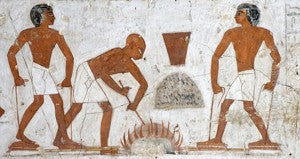
Forged in Time: Unraveling the Mystique of Metalwork in Ancient Egypt
Share
In the cradle of civilization along the banks of the Nile, ancient Egypt flourished as a beacon of innovation and sophistication. Beyond the iconic pyramids and hieroglyph-laden walls, another facet of this rich civilization quietly shaped its identity—metalwork. Join me on a journey through the annals of history as we unravel the meticulous craftsmanship and technological prowess that defined ancient Egyptian metalwork.
**Copper: The Foundation of Early Metallurgy (circa 3300 BCE)**
The roots of Egyptian metalwork trace back to the dawn of the third millennium BCE, during the predynastic period. Copper, abundant in the Egyptian soil, became the primary metal of choice. The mastery of extracting and working with copper marked the inaugural chapter of a craft that would evolve over the centuries.
Early metalworkers fashioned copper into tools, utensils, and simple adornments. The utilitarian nature of these early creations hinted at the pragmatic mindset that characterized ancient Egyptian society.
**Bronze Age Brilliance (circa 2800 BCE)**
Around 2800 BCE, the Egyptian metalworking landscape underwent a transformative shift with the discovery and integration of tin. The marriage of copper and tin birthed bronze, a more durable and versatile alloy. This technological leap marked the Bronze Age in Egypt, ushering in an era of unparalleled craftsmanship.
Bronze artifacts began to grace the tombs of pharaohs and nobility, adorned with intricate designs that showcased the evolving skill of Egyptian artisans. The newfound material allowed for greater intricacy in sculpting tools, weaponry, and ceremonial objects, demonstrating the growing sophistication of metalwork.
**The Lost-Wax Technique: A Precision Artform (circa 2000 BCE)**
A pivotal development in ancient Egyptian metalwork was the mastery of the lost-wax casting technique. This intricate process allowed artisans to create detailed and finely crafted metal objects. The method involved creating a wax model, encasing it in clay, and then melting away the wax to create a mold for casting. This technique elevated metalwork to an art form, enabling the production of ornate jewelry, statuettes, and ceremonial items with exquisite precision.
**New Kingdom Elegance (1550–1070 BCE)**
The New Kingdom, often considered the zenith of ancient Egyptian power and influence, witnessed a golden age of metalwork. Pharaohs such as Tutankhamun and Ramses II adorned themselves with regalia crafted from gold and bronze. The funerary mask of Tutankhamun, an iconic masterpiece, exemplifies the unparalleled artistry of the time.
Metalwork during the New Kingdom reflected a fusion of practicality and elegance. Everyday objects, from mirrors to containers, displayed a harmonious balance between form and function. The meticulous attention to detail showcased the craftsmanship that defined the daily lives of Egyptians during this prosperous era.
**Iron: A Latecomer to Egyptian Metallurgy (circa 1200 BCE)**
While copper and bronze held sway for centuries, a transformative moment arrived around 1200 BCE with the introduction of iron. Unlike its predecessors, iron was not native to Egypt, necessitating the development of new techniques for its extraction and manipulation. The adoption of iron tools and weapons marked a technological leap, providing practical advantages in agriculture, construction, and warfare.
**Decline and Transformation (circa 600 BCE onward)**
The decline of the New Kingdom marked a period of economic and political upheaval, influencing the trajectory of Egyptian metalwork. The depletion of local ore sources and shifts in trade patterns contributed to a decline in the prominence of iron. However, this era also witnessed a shift in artistic preferences, with a resurgence of interest in traditional materials like gold and bronze.
As Egypt entered the first millennium BCE, the dynamics of metalwork underwent transformation. While iron continued to play a role in practical applications, the focus shifted back to the timeless allure of gold and the enduring charm of bronze.
In conclusion, the story of metalwork in ancient Egypt is a tale of evolution and adaptability. From the foundational use of copper to the brilliance of the Bronze Age, the precision of the lost-wax technique, and the transformative introduction of iron, Egyptian metalwork reflects a civilization in constant dialogue with the materials at its disposal. As we trace the arc from utility to artistry, we glimpse not just the tangible artifacts but also the ingenuity and sophistication that shaped the metalworking traditions of this ancient and revered civilization.
